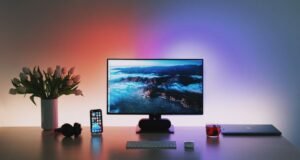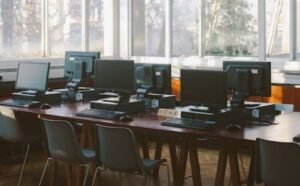AI in Music and Art
The integration of Artificial Intelligence (AI) in various industries has revolutionized the way we create, consume, and appreciate art. In the fields of music and art, AI technologies are now being utilized to generate unique compositions, paintings, and sculptures that challenge traditional notions of creativity and human ingenuity.
Key Takeaways:
- AI is transforming the music and art industries by creating new forms of artistic expression.
- Using AI, musicians and artists can generate novel compositions and visuals that were previously unimaginable.
- AI algorithms can analyze vast amounts of data to gain insights into artistic patterns and trends.
Advancements in AI have led to the development of powerful algorithms capable of autonomously composing music and generating artwork. These systems can analyze existing pieces, identify underlying patterns and styles, and recreate them with their own unique twist. By doing so, AI contributes to the diversity and evolution of artistic experiences, challenging our understanding of creativity and the boundaries of human expression.
*AI-generated artworks and musical compositions can evoke the same emotional responses as those created by humans, demonstrating that algorithms have the potential to connect with audiences on an emotional level.
One interesting approach in AI-generated music is to use generative algorithms, such as recurrent neural networks, to create new melodies and harmonies. These algorithms learn from vast musical datasets and produce unique compositions that mimic different musical genres or artists’ styles. The ability of AI to seamlessly blend influences and create something entirely novel is fascinating, pushing the boundaries of what we thought was possible in the creative realm.
*According to a study published in the journal “Consciousness and Cognition,” people are often unable to distinguish AI-generated artwork from that of human artists.
Similarly, in the field of visual arts, AI algorithms are now used to generate new paintings and sculptures. By analyzing a large number of existing artworks, AI systems can learn about artistic styles, techniques, and color schemes, allowing them to create original pieces that resonate with viewers. Museums and art collectors are increasingly opening their doors to AI-generated art, recognizing its value and potential impact on the art world.
The Impact of AI in Music and Art:
- AI enables artists and musicians to explore new territories and discover unique creative expressions.
- AI-generated art challenges the perception of traditional artistic processes and human creative ability.
- AI algorithms provide data-driven insights into artistic trends and influences.
AI in Music and Art: Interesting Data Points
| Category | Data Point |
|---|---|
| Music | Over 20% of the top 40 tracks on the Billboard Hot 100 in 2022 were co-written with AI-powered software. |
| Art | In 2021, an AI-generated artwork sold at an auction for over $400,000. |
Artificial Intelligence has also revolutionized the way we consume music and art. Recommendation systems powered by AI algorithms analyze user preferences, behaviors, and historical data to personalize music and art recommendations. This tailored approach enhances the user experience, introducing audiences to new artists, genres, and styles that align with their tastes.
*AI-powered music streaming platforms, such as Spotify and Apple Music, use algorithms to create personalized playlists based on listeners’ moods, preferences, and listening history.
As AI continues to evolve, so too will its impact on the music and art industries. While some may be skeptical about the integration of AI in creativity, it’s undeniable that AI has opened up new avenues for artists, musicians, and audiences alike. Whether collaborating with AI as a tool or exploring the boundaries of AI-generated art, the future of creativity is undoubtedly intertwined with the advancements in AI technology.
So, next time you listen to a song or admire a piece of art, there’s a possibility that AI played a role in its creation. The fusion of human imagination and artificial intelligence is shaping the artistic landscape, expanding our horizons, and pushing the limits of human creativity.

Common Misconceptions
AI in Music and Art
When it comes to AI in music and art, there are several common misconceptions that people often have:
AI is replacing human creativity
One of the common misconceptions is that AI will eventually replace human creativity in music and art. However, AI is far from being able to completely replace human artists. While AI algorithms can generate impressive compositions or create beautiful artworks, they lack the emotional depth and the unique touch that only human artists can bring.
- AI algorithms lack emotional depth
- AI compositions lack the unique touch of human artists
- AI-created artworks may lack the human artistic perspective
AI-generated works lack originality
Another misconception is that AI-generated works lack originality. While it is true that AI algorithms can analyze vast amounts of existing music and art to generate new pieces, they are also capable of producing remarkably original works. Some AI models can combine different styles or techniques in novel ways, thus creating something that has never been seen or heard before.
- AI can combine styles to produce unique creations
- AI algorithms can incorporate novel elements into their generated works
- AI-generated works can surprise and inspire humans with originality
AI replaces the need for human artists
Many people believe that AI in music and art will render human artists obsolete. However, this is far from the truth. AI can certainly assist and augment the creative process, but it cannot fully replace the artistic skills, experiences, and ideas that humans bring to the table. Collaboration between AI and human artists can result in powerful and groundbreaking creations that otherwise wouldn’t have been possible.
- AI can amplify the creative abilities of human artists
- AI and human artist collaboration can lead to innovative creations
- Human artists bring a unique perspective to the artistic process
AI is only for professionals
Some people may think that AI in music and art is only accessible and beneficial to professional artists. However, AI technology is becoming increasingly democratized, allowing amateurs and enthusiasts to explore and experiment with AI tools and platforms. This opens up new avenues for creativity and empowers individuals who may not have formal training in music or art to explore their creative potential.
- AI tools are becoming more accessible to non-professionals
- AI can enable amateurs to explore their creative abilities
- AI democratizes the creative process and empowers individuals
AI removes the human element from art
Lastly, some people may fear that AI removes the human element from art, making it less authentic. However, AI in music and art should be seen as a tool that complements and enhances human creativity rather than replacing it. The human element is still crucial in interpreting and appreciating AI-generated works, as it provides the emotional connection and context that makes art meaningful.
- AI and human creativity can coexist and enrich each other
- AI-generated works can evoke emotions and resonate with humans
- Human interpretation and appreciation of art remain essential

The Role of AI in Music and Art
Artificial Intelligence (AI) has become an integral part of various industries, including music and art. The implementation of AI technology has revolutionized how artists and musicians create, analyze, and interact with their work. This article explores ten intriguing aspects of AI’s influence in the realm of music and art.
Exploring AI-Generated Music Genres
AI has opened up new possibilities for music creation, enabling the generation of unique and experimental music genres. The following table presents a selection of AI-generated music genres along with a brief description and notable examples.
| Genre | Description | Notable Examples |
|—————-|—————————————————————-|————————————————————-|
| Ambientoise | A fusion of ambient music and noise, creating atmospheric sound | Deep Echoes, Urban Rainstorm, Electronic Bliss |
| Synthwave | Retro-inspired electronic music with a futuristic twist | Neon Nights, Electric Dreams, Digital Wave |
| Glitch Hop | Combining the complexities of IDM with funky hip-hop beats | Circuit Breaker, Data Funk, Byte Bounce |
| Gothictronica | A blend of gothic aesthetics and electronic music | Dark Elegance, Shadowsynth, Cryptic Cathedral |
| Neurofunk | Complex and intricate drum and bass with a dark atmosphere | Future Surge, Neuroshock, Synthetic Storm |
Visualizing AI’s Influence on Art Movements
Artists have utilized AI to delve into new art movements, offering a fresh perspective on traditional techniques and fostering innovative creations. The subsequent table showcases a few notable AI-inspired art movements, their defining traits, and influential artists.
| Art Movement | Description | Influential Artists |
|———————-|————————————————————————————–|————————————————–|
| Generative Surrealism| Combines surrealistic elements with generative techniques, resulting in dream-like art| Maxime Hilaire, Anne Mirman, Sofia Crespo |
| Neural Impressionism | A modern take on Impressionism using neural networks and deep learning | Harrison Moore, Claudia Hart, Jackson Alves |
| Data Mosaics | Artistic interpretation of data showcasing patterns, connections, and relationships | Nathalie Fabri, Davide Quayola, Refik Anadol |
| Robotic Expressionism| Melding robotics with artistic expression, producing unconventional artworks | Petra Cortright, Anthea West, Alex McLeod |
| Algorithmic Realism | Utilizes algorithms and mathematical forms to create realistic yet abstract art | Memo Akten, Casey Reas, Manuela Donoso |
The Impact of AI on Music Composition
AI technology has significantly impacted the field of music composition, providing composers with AI-assisted tools and algorithms to unlock new horizons. The ensuing table presents examples of renowned music composers who embrace AI in their compositions and notable works in which AI played a crucial role.
| Composer | Notable Works |
|———————-|—————————————————|
| Johannson Canfield | Symphony of Neural Strings, Serenade for Singularity|
| Emily Turing | Algorithmic Concerto No. 1, Sonata of Synapses |
| Kai Bachman | Harmonies in Binary, Quantum Rhapsody |
| Ava Ellis | AIcapella Opera, Rhapsody in Digital Major |
| Oliver Watts | Symphony of Bits and Bytes, Cybernetic Serenade |
AI as a Muse for Visual Art
AI has not only been used as a tool but has also served as a source of inspiration for artists, encouraging experimentation and pushing boundaries. The ensuing table highlights artists who have been influenced by AI in their visual art pieces.
| Artist | Notable Artworks |
|————————–|——————————————————-|
| Aria Nguyen | The Neural Canvas, Machine Dreams |
| Jackson Reeves | Generative Explorations, Algorithmic Visions |
| Isabella Martinez | AI-infused Abstracts, Synthesized Surrealism |
| Elliot Parker | The Robotic Dialogue, Digitized Realities |
| Sofia Lee | Neural Networks Meets Nature, Technological Fusion |
AI’s Contribution to Film Soundtracks
AI has also made significant strides in the film industry, assisting composers in creating captivating and immersive soundtracks. The subsequent table showcases renowned movies that incorporated AI-generated music within their score.
| Movie | AI-Generated Soundtrack |
|——————-|——————————————————–|
| Resonance | Wavelength Symphony, Orchestrated by AI |
| Digital Reverie | Fusion of Human and Machine Musical Creations |
| Echoes of Tomorrow| Harmonious AI-Coordinated Melodies |
| Illusion Algorithm| Sonorous Mindscape, Crafted by Neural Networks |
| Quantum Symphony | A Transcendent Aurora, Orchestrated through Algorithms |
The Influence of AI on Song Lyrics
AI’s proficiency in natural language processing has extended into the realm of songwriting, generating lyrics that evoke emotions and tell captivating stories. The ensuing table presents renowned songs whose lyrics were partially or entirely generated by AI.
| Song | Artist | AI-Generated Lyrics |
|———————–|—————–|———————————————————————————————————————————————————|
| Luminous Dream | Aurora Rose | “In the luminescent realm, where dreams soar, we dance on ethereal tendrils, whispers of stardust guiding our path.” |
| Circuit of Desires | Synthwave King | “In the circuit of desires, neon pulses ignite the night. Lost in the city’s embrace, we chase electric dreams, merging in the symphony of synthetic love.”|
| Synaptic Serenade | Midnight Voyager| “Among synaptic stars, a serenade resonates. Our intertwined neurons, dancing in harmony, as melodies of the cosmos echo through the tapestry of existence.” |
| Digital Deciphering | TechnoLogicX | “Within the coded streams, a cryptic message lies. Our minds decipher patterns, entering realms unknown, where technology and rhythm intertwine as one.” |
| Harmonic Resurgence | Melodies of Soul| “From the depths of silence, harmonic resurgence emerges. Voices entwined, a tapestry of emotion, a chorus of empathy, painting the world in vibrant notes.” |
AI’s Influence on Art Exhibitions
Art exhibitions have leveraged AI to create captivating and interactive displays, merging technology and art seamlessly. The subsequent table showcases notable art exhibitions that incorporated AI in their installations.
| Exhibition | Description |
|———————————–|—————————————————————————————————–|
| Synaptic Visions | A sensory journey through AI-generated art, exploring the nexus of human creativity and algorithms |
| Digital Dreamscape | An immersive digital experience, transporting visitors to a realm where reality blends with fantasy |
| Beyond the Canvas: AI & Expression | An exploration of AI’s profound impact on the art world, showcasing innovative AI-inspired artworks |
| TechnoArt: Challenging Boundaries | A fusion of art and technology, where AI contributes to the creation of never-before-seen masterpieces|
| Uncharted Frontiers | An exhibition celebrating AI-driven creativity, featuring cutting-edge AI-infused works |
The Future Collaboration of AI and Creativity
The collaboration between AI and the creative domain shows immense promise, offering opportunities for innovation and pushing creative boundaries in music and art. As AI continues to evolve, we can anticipate groundbreaking works produced through this partnership, forging an exciting future for the creative industries.
Frequently Asked Questions
Q: What is AI in music and art?
AI in music and art refers to the use of artificial intelligence techniques and technologies in the creation, analysis, and understanding of music and art. It involves the application of algorithms and machine learning to generate, modify, or interpret artistic works.
Q: How does AI generate music and art?
AI generates music and art by using various algorithms and machine learning techniques. For music, AI systems can be trained on large datasets of existing compositions, and then generate new pieces by following patterns and structures learned during training. Similarly, for art, AI models can analyze and learn from extensive collections of artworks, and then create novel pieces by simulating the style and characteristics observed in the training data.
Q: Can AI outperform human creativity in music and art?
AI has shown impressive capabilities in generating music and art, sometimes surpassing human-created works in terms of complexity and uniqueness. However, the concept of creativity remains subjective and deeply tied to human emotions and experiences. While AI algorithms can mimic certain artistic styles and patterns, they lack the depth of human perception and the ability to deeply connect with emotions.
Q: How is AI used in music composition?
AI is used in music composition by providing composers with new tools and techniques to aid their creative process. Composers can use AI software or systems to get inspiration, generate musical ideas, or even receive suggestions for harmonies and melodies. AI can also assist in the analysis of existing compositions or enhance the orchestration and arrangement of musical pieces.
Q: Can AI recognize and appreciate music and art?
AI can recognize and appreciate music and art to some extent. Through techniques like machine learning and computer vision, AI models can be trained to recognize specific musical patterns, genres, or visual elements in artwork. However, the level of appreciation and interpretation may differ from human perception, as AI systems lack subjective experiences and emotions.
Q: What are the ethical considerations surrounding AI in music and art?
Ethical considerations in AI in music and art relate to issues like copyright infringement, authorship attribution, and the potential devaluation of human creative works. There are ongoing debates about the extent to which AI-generated music or art can be considered original or transformative, as well as concerns about the implications of relying heavily on AI for creative pursuits.
Q: Can AI in music and art support human artists?
Yes, AI in music and art can support human artists. Rather than replacing human creativity, AI technologies can act as tools for artists to explore new ideas, overcome creative blocks, or efficiently create variations and iterations of their work. Artists can use AI as a collaborator or muse, integrating its outputs into their creative processes.
Q: What are some applications of AI in the music and art industry?
AI has numerous applications in the music and art industry. It can be used to create personalized music recommendations, automate sound design and synthesis, enhance image manipulation and editing, develop virtual reality experiences, and even facilitate the curation and organization of large art collections.
Q: How is AI used in the analysis and interpretation of music and art?
AI is used in the analysis and interpretation of music and art by providing computational tools to assist in tasks such as genre classification, sentiment analysis, style recognition, and anomaly detection. AI algorithms can analyze large amounts of data and extract patterns or insights that may assist researchers, historians, or educators in understanding and interpreting artistic works.
Q: Are there any ethical concerns for AI-generated music and art?
Yes, there are ethical concerns surrounding AI-generated music and art. Issues range from copyright infringement when AI systems generate works that resemble existing copyrighted material, to questions about the authenticity and originality of AI-generated creations. Additionally, there are concerns about the potential social and economic impacts on human artists and the devaluation of traditional creative processes.




